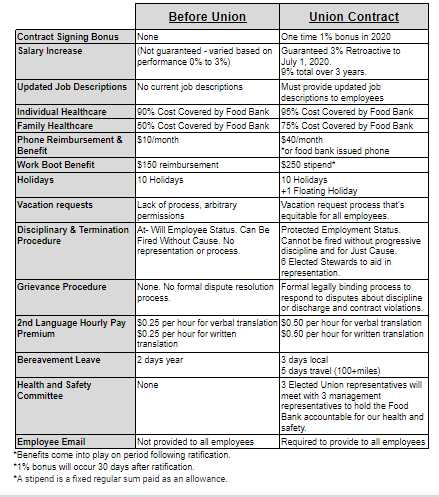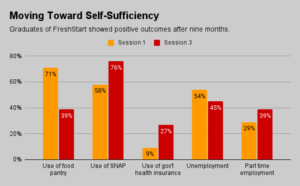A yearly pay increase of 3%, a floating holiday, and a boot stipend for warehouse workers are among the benefits that employees of San Francisco-Marin Food Bank have gained since they’ve unionized.
The food bank became the one of the few in the country to recognize a union in late 2019 when 75% of staffers voted in favor of becoming a member of NY-based OPEIU (Office and Professional Employees International Union). With union-organizing riding a small wave of popularity in recent months, organizers there are now eager to put forth their experience as a potential blueprint for other nonprofits.
Last week, two employees of the food bank outlined the benefits of union-organizing in an online forum sponsored by the Next Shift Campaign, an arm of Closing the Hunger Gap. Next Shift’s view is that dismantling the root causes of hunger starts within the hunger relief sector itself, through efforts like paying living wages that allow employees to prosper and thrive.
“The change starts with us,” said Alison Cohen, an independent consultant supporting hunger relief organizations and the moderator of the event.

Many food banks across the country have already received that message, and are moving to lift pay, as Food Bank News reported in May. Regional Food Bank of Oklahoma, for example, recently increased its base pay by an amount that pushes nearly 75 staffers into a living wage. Oregon Food Bank recently approved a hike in its minimum wage, and will increase it again later this year. This wage trend points to potential pathways for improving employee-management relations that do not involve union organizing.
At San Francisco Marin Food Bank, the union has helped bring about a number of positive changes in the work environment, employees said. In September 2020, the union helped usher in the food bank’s first labor contract, after nearly nine months of negotiation. In addition to the guaranteed 3% wage increases, the contract also includes improved healthcare benefits, more generous phone reimbursements and defined procedures for grievances and terminations, among other improvements (see chart).
Since the contract went into effect, management has also voluntarily stepped up with additional benefits. Just a few weeks ago, for example, it instituted a round of pay equity raises, under which employees in the lowest pay grade get the highest possible percentage increase, while those at the highest pay grade get the lowest.
“This was justice for folks who were being underpaid,” said Marchon Tatmon, who works as a senior government affairs manager at the food bank. He indicated that the union has helped create an environment in which management now acts more proactively in consideration of workers. “We really feel the union helped them explore this as an opportunity to do what was right,” he said.
Another benefit of the union is that employees feel better equipped to serve the community, said Emily Citraro, who works as department operations coordinator. For example, when workers out in the field sensed a need to serve more culturally relevant food, they were able to collaborate with managers to make that happen. “It’s been clear to us that we’re able to better serve our community because now we have this union,” she said.
The idea of a union at the food bank gained credibility over time, as worker dissatisfaction mounted in response to certain managerial moves, such as staff reorganizations without any employee input. According to Citraro, turnover was high and morale was low. “The sense that a union could be a solution came to a lot of us because the situation was so painful,” she said.
The employees indicated that forming a union has fostered improved relations between staff and leadership, which now includes an executive director who was hired just over a year after the union was formed. “Workers feel more engaged, they’re empowered and they have agency,” Citraro said. “We do have a sense that our voices are being heard.”
A food bank spokesperson said that leadership “is committed” to a positive working relationship with the union. “We support our employees’ right to unionize and their desire to create more opportunities for employees to have a voice within the organization and have power and influence over decision-making,” the spokesperson said in an emailed statement.
Food bank employees interested in forming a union should first identify the issues that need to be addressed and any efforts already taken to resolve them, said Andom “Nati” Kahsay, an organizer at OPEIU. If the issues remain unresolved, then employees should identify workplace leaders to help determine if a union is the proper response and then work to build community support for it. – Chris Costanzo
Like what you’re reading?
Support Food Bank News
This article was made possible by the readers who support Food Bank News, a national, editorially independent, nonprofit media organization. Food Bank News is not funded by any government agencies, nor is it part of a larger association or corporation. Your support helps ensure our continued solutions-oriented coverage of best practices in hunger relief. Thank you!
Connect with Us:















